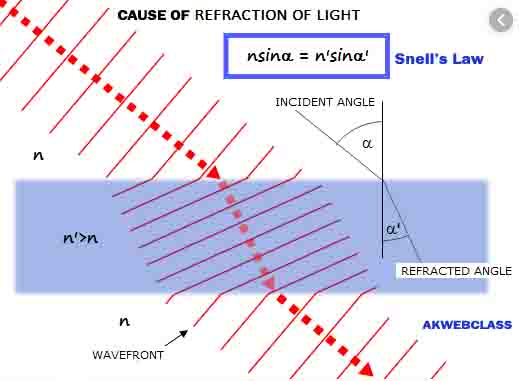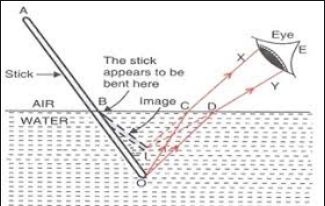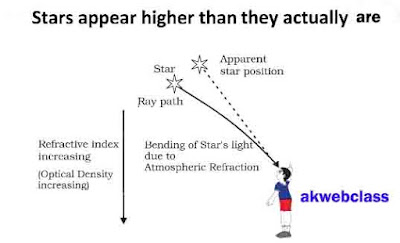 |
| Cause and effect of Refraction : light class 10 science cbse board |
Cause of Refraction
When light goes from one medium to another, its speed changes. And this change in speed of light causes the refraction of light. Thus the refraction of light is due to the change in the speed of light on going from one medium to another.
For example, the speed of light in air is 3 x 108 m/s whereas that in glass is 2 x 108 m/s. when light enters from air into glass, its speed is reduced. And this change in speed of light in going from air to glass causes the refraction of light .
Why a Change in Speed of Light Causes Refraction of Light (or Bending of Light)
The refraction of light or change in direction of light on going from one medium to another can be explained by using the wave theory of light. A beam of light is made up of tiny waves.
 |
| Cause of Refraction |
When a beam of light falls obliquely on the boundary of another medium, then one part of the light waves enters into the other medium first and its speed changes first but the reșt of waves enter the other medium a little later and hence its speed changes a little later.
The fact that the speed of light waves on one side of a beam of light changes a little before the change in speed of light waves on its other side, causes a change in the direction of light. And this change in direction of light is called refraction of light or bending of light.
Explanation :
A beam of light is entering from air into a glass slab obliquely and then emerging into air from its other side.
Light waves travel faster in air but slower in glass. When a beam of light consisting of light waves and travelling in air falls on a glass slab obliquely then the part of light waves on the left side of the beam of light reach in glass first.
The rest of light waves on the right side of the beam of light are still in air and have to travel more distance in air before reaching the glass slab (at point B) and hence slow down a little later on entering - the glass slab.
When the beam of light travelling in glass slab comes out into air obliquely, then the part of light waves on the left side of beam of light emerges out into air first and speeds up first. The part of light waves on the right side of beam of light emerges out into air a little later and hence its speed increases a little later. Since the speed of left side of the beam of light increases a little before its right side, therefore, the direction of light changes on coming out of glass slab into air .
When light waves móve from air into glass, their speed decreases and their wavelength also decreases (they become closer). On the other hand, when light waves come out from glass into air, their speed increases and their wavelength also increases (they become farther apart).
Optically Rarer Medium and Optically Denser Medium :
A transparent substance in which light travels is known as a medium.
e.g Air, glass, certain plastics, water, kerosene, alcohol, etc., are all examples of medium. Different media are said to have different optical densities.
Optically rarer medium :
A medium in which the speed of light is more is known as optically rarer medium (or less dense medium).
e.g Air is an optically rarer medium as compared to glass and water.
Optically denser medium :
A medium in which the speed of light is less, is known as optically denser medium. E.g Glass is an optically denser medium than air and water.
The refraction of light takes place whenever it goes from an optically rarer medium to an optically denser medium; or from a denser medium to a rarer medium.
EFFECTS OF REFRACTION OF LIGHT
The refraction of light produces many effects which can be easily observed in our day to day life. some of the important effects of the refraction of light are .
(i) a stick (or pencil) held obliquely and partly immersed in water appears to be bent at the water surface.
(ii) an object placed under water appears to be raised.
(iii) a pool of water appears to be less deep than it actually is.
(iv) when a thick glass slab is placed over some printed matter, the letters appear raised when viewed from the top.
(v) a lemon kept in water in a glass tumbler appears to be bigger than its actual size, when viewed from the sides.
(vi) the stars appear to twinkle on a clear night.
All these effects are preduced by the refraction of light.
A Stick Partly Immersed in Water Appears to be Bent at the Water Surface :
When a straight stick is partly immersed in water and held obliquely to the surface, it appears to be bent at the point where it enters water .This apparent bending at the stick is due to the refraction of light .
 |
| A Stick Partly Immersed in Water |
A straight stick AO whose lower portion BO is immersed in water. Though the stick is actually straight but on immersing in water, it appears to be bent at point B, in the direction BL.
This can be explained as follows :
A ray of light OC coming from the lower end O of the stick passes from water into air at point C and gets refracted away from normal in the direction CX (because it passes from a denser medium water into a rarer medium air). Another ray of light OD gets refracted in the direction DY. The two refracted rays CX and DY, when produced backwards, appear to meet at point L , nearer to the water surface than point O.
Thus, L is the virtual image of the end O of the stick which is formed by the refraction of light on going from water to air.
An Object Placed Under Water Appears to be Raised
The object under water appears to be raised (and becomes visible) due to the refraction of light which takes place when it goes from water into air.
 |
| Object Placed Under Water |
When the object is under water, then rays coming from the object travel in water in straight line paths until they reach the surface of water. When the rays of light travelling in water, go out into air, they get refracted . If we extend the refracted rays backwards (to the left side), then a virtual image of the object is formed at point B, nearer to the surface of water .
The refracted rays which appear to be coming from the virtual image of the object can enter our eye due to which the object becomes visible to us.
Note : this theory is applicable for all tranparent medium .
ATMOSPHERIC REFRACTION
All the air in the atmosphere is not at the same temperature. Some of the air layers of the atmosphere are cold whereas other air layers of the atmosphere are comparatively warm (or hotter).
The cooler air layers of the atmosphere behave as optically denser medium for light rays whereas the warmer air layers of the atmosphere behave as optically rarer medium for the light rays. So, in the same atmosphere we have air layers having different optical densities.
When light rays pass through the atmosphere having air layers of different optical densities, then refraction of light takes place. The refraction of light caused by the earth's atmosphere is called atmospheric refraction.
Under normal circumstances, the air in the upper atmosphere is optically rarer and as we come down, the air in the lower atmosphere is optically denser. This arrangement of optical densities of air in the atmosphere change according to the local conditions such as temperature, etc., at a particular place.
Some phenomena in nature which occur due to the atmospheric refraction of light.
Some phenomena in nature which occur due to the atmospheric refraction of light.
1. Twinkling of Stars
The brightness of star-light reaching our eyes increases and decreases continuously due to atmospheric refraction. Thus the star appears to twinkle at night.
Explanation :
 |
Twinkling of Stars |
When the light coming from a star enters the earth's atmosphere, it undergoes refraction due to the layers of varying optical densities of air at various altitudes. The continuously changing atmosphere refracts the light from the stars by different amounts from one moment to the next.
When the atmosphere refracts more star-light towards us, the star appears to be bright and when the atmosphere refracts less star-light, then the star appears to be dim. In this way, the star-light reaching our eyes increases and decreases continuously due to atmospheric refraction. And the star appears to twinkle at night.
Stars twinkle at night but planets do not twinkle at all
The stars appear very, very small to us (because they are very, very far off). So, stars can be considered to be point sources of light.
On the other hand, the planets appear to be quite big to us (because they are much nearer to the earth). So, a planet can be considered to be a collection of a very large number of point sources of light. The dimming effect produced by some of the point sources of light in one part of the planet is nullified by the brighter effect produced by the point sources of light in its other part. Thus the brightness of planet -light reaching our eyes is nearly constant . so the planet does not appears to twinkle at night.
The Stars Seem Higher Than They Actually Are
Due to atmospheric refraction, the stars seem to be higher in the sky than they actually are. This can be explained as follows :
 |
| effect of Refraction |
Light from a star is refracted (bent) as it leaves space (a vacuum) and enters the earth's atmosphere. Air higher up in the sky is rarer but that nearer the earth's surface is denser. So, as the light from a star comes down, the dense air bends the light more. Due to this refraction of star's light, the star appears to be at a higher position.
Advance Sunrise and Delayed Sunset
we can see the sun about 2 minutes before the actual sunrise and 2 minutes after the actual sunset because of atmospheric refraction.
 |
| Advance Sunrise and Delayed Sunset |
When the sun is slightly below the horizon, then the sun's light coming from less · dense air to more dense air is refracted downwards as it passes through the atmosphere of earth . Because of this atmospheric refraction, the sun appears to be raised above the horizon when actually it is slightly below the horizon.


No comments:
Post a Comment